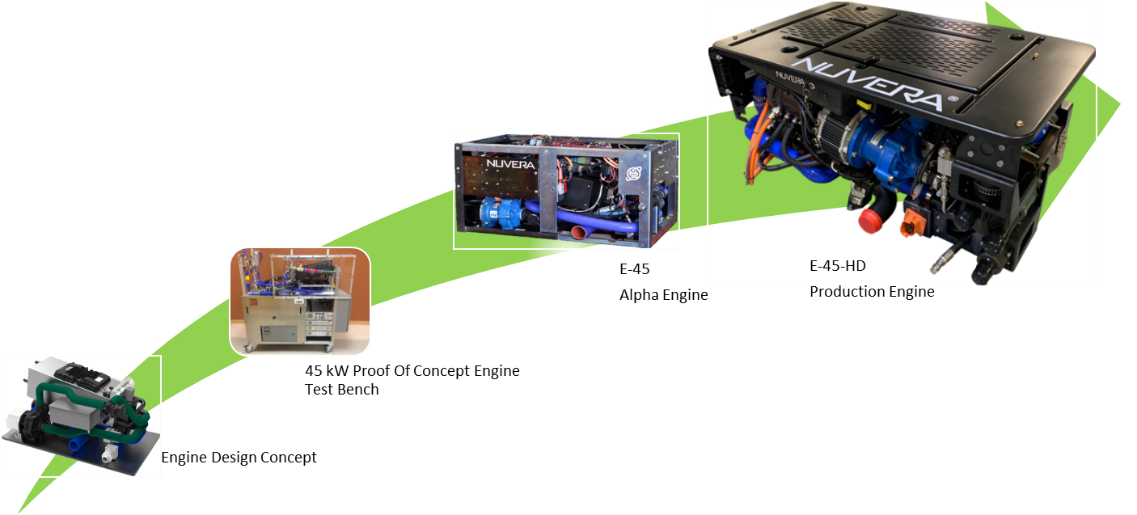Matt Weig, Fuel Cell Engine Product Development Manager
As we launch the Nuvera® E-45 fuel cell engine for medium- and heavy-duty vehicle applications, we wanted to look back at how we arrived at this moment. Nuvera has been at the forefront of the fuel cell industry for over 20 years. Throughout that time, we have always believed that hydrogen represents the future of energy for mobility, and we have worked hard to develop unique technology that makes the use of hydrogen make financial and environmental sense for commercial operations. As governments around the world begin restricting the use of internal combustion engines and diesel fuel, it’s exciting to see how quickly the use of hydrogen fuel cells for zero-emission transportation has come to the forefront of consideration by fleet operators of all kinds.
As a result, the demand for reliable, high-power fuel cell motive power systems is growing fast. The material handling industry was one of the first to adopt fuel cells on a large scale, and in 2005 Nuvera began developing fuel cell products that are interchangeable with lead acid batteries used in forklift trucks. Our “battery box replacements” (BBRs) are ramping up in production, providing high-productivity material handling solutions for major brands that provide the foundation for their use in other demanding applications. Many industries besides material handling have recognized the unique benefits that fuel cells have to offer for electrified transportation: zero tailpipe emissions, fast refueling, sustained performance in cold environments, and increased range and payload capabilities compared to battery-powered vehicles. To meet the growing demand for fuel cell power for motive applications, Nuvera began development of a high-power fuel cell engine for integration into both on- and off-road vehicles and equipment.
Our strategy for the Nuvera® E-45 fuel cell engine was to design a system that can meet the needs of multiple markets and that takes advantage of our unique core stack technology, packaged in a way that system integrators and electric vehicle manufacturers can easily incorporate it into their vehicle platforms, and which provides ready access for maintenance. As we went through the process to define the requirements for the Nuvera engine – in many ways the functional equivalent of an internal combustion engine – our product development team identified 45 kW as the power rating best suited to meet the requirements of emerging electric vehicle markets around the world: delivery vans, passenger transport, industrial trucks, yard tractors, and many more. Having defined the engine requirements based on extensive customer interactions, we have proceeded through the stages of a rigorous product development process to move from the original concept to a full production version of an engine intended to exceed customer expectations.
our product development team identified 45 kW as the power rating best suited to meet the requirements of emerging electric vehicle markets around the world: delivery vans, passenger transport, industrial trucks, yard tractors, and many more. Having defined the engine requirements based on extensive customer interactions, we have proceeded through the stages of a rigorous product development process to move from the original concept to a full production version of an engine intended to exceed customer expectations.
In previous blog posts we have discussed how the equipment used to move containers into and out of shipping ports is an ideal application for fuel cell power systems, eliminating the emissions associated with diesel engines. Through our partnership with Hyster-Yale Group, Nuvera has incorporated the E-45 engine into a Hyster® top-loading container handler (“top-pick”), which will begin operation this year at the Port of Los Angeles. For large vehicles like the top-pick and the Hyster® reachstacker—another type of container handler that is being developed for use at the Port of Valencia, Spain initially—two 45 kW Nuvera engines were integrated into the vehicles in order to meet their peak power requirements for these trucks. The E-45 engine modularity can be used for other on- and off-road applications in the 100 kW range, or even higher.
Beyond port equipment, buses, yard trucks, and other logistics vehicles are applications well-suited for the Nuvera® E-45 engine, and in our view offer the greatest opportunity for large-scale adoption of fuel cell engines in the near term. Fleet vehicles have the advantage of being fueled at a dedicated location, without the need of widespread hydrogen infrastructure, which is still emerging. We are working with companies around the globe to integrate the E-45 engine into a variety of vehicles and applications. Even as our focus is on getting the engine into full-scale production and used widely in a range of applications, our development team continues to gather input from our customers and use it to continuously improve our products. As the increasing availability of hydrogen as a transportation fuel makes vehicle electrification possible and practical, we look forward to powering zero-emission medium- and heavy-duty vehicles in the most demanding applications with Nuvera® E-45 engines.
